|
|
YOU'VE NEVER SEEN OZ LIKE THIS!
The Best 'Oz' Ever! (Entertainment Weekly) -- The 1999 "Oz" disc was crammed full of magical extras -- deleted scenes, documentaries, screen tests. The package was so pristine it was named EW's DVD of the year.
You can now throw it away. That's because an exhaustive new set featuring all this plus oodles more proves as precious as Dorothy's ruby slippers.
Following the yellow brick road of "The Wizard of Oz" through all three discs takes about 15 hours, but it's a journey every film buff should make. A plethora of docs cover Toto's real gender (he is actually a she), the feminist interpretation of the film (beyond Toto, of course), and "the advent of a breakthrough technology -- lip-synching."
And the five previous versions of "Oz" include a slapsticky entry from 1925 with Oliver Hardy as the Tin Woodsman and a truly bizarre ending in which the Scarecrow apparently plunges to his death (talk about brainless).
The film looks fabulous thanks to a fancy-schmancy process called Ultra-Resolution (there's a doc on that too), and features a top-notch track of old interviews with the cast and poor Buddy Ebsen, who was bumped from the role of Scarecrow and then forced to bow out as the Tin Man after having an allergic reaction to the aluminum-dust makeup.
"They thought I bore a grudge and now I was going to get even with them," says Ebsen. "They never quite believed that I was really sick." What's truly sick is the astounding wealth of information and archival footage here.
As Peter Jackson says in one of the extras, "You can feel the heart and care that's gone into every frame of that film." You could say the same for the entire package.
EW Grade: A
____________________
THE RETURN OF 'OZ'
"There's no place like home. There's no place like home. There's no place like home."
It's remarkable to think that the 1939 movie classic "The Wizard of Oz" we all know and love wasn't always as popular as it is today. At the film's opening, observers gave it mixed reviews. "As for the light touch of fantasy," wrote critic Otis Ferguson, "it weighs like a pound of fruitcake soaking wet." And critic Richard Mallett said, "I don't see why children shouldn't like it, but for adults there isn't very much except Bert Lahr."
Although the film enjoyed a profit at the box office, being re-released in the U.S. in 1949 and 1955, it would not realize its current status as a cultural icon until it began appearing as an annual special event on TV, premiering on network television in 1956 and beginning its historic run in 1959. After that, there was no stopping it. When MGM made the film, they had hoped it might achieve the success of Walt Disney's "Snow White and the Seven Dwarfs." Little did they know it would take more than a quarter of a century to date...one of the most enduring musical fantasies of all time.
Now, after issuing several previous DVD editions, Warner Bros. have released the movie in their biggest and best sets yet, the one reviewed here a "Three-Disc Collector's Edition," with a totally restored picture, improved sound, and ton of extras. Who'da thunk?
You see, it's a wonder "The Wizard of Oz" got made at all. Based largely on the first book (1900) in a long series of children's novels by L. Frank Baum and his successors, the 1939 movie followed a handful of silent versions that never achieved great distinction. MGM went through a number of directors, including Richard Thorpe, George Cukor, and King Vidor, with Victor Fleming receiving the credit, to get the thing done. The studio had originally wanted W.C. Fields or Ed Wynn to play the Wizard, but they got Frank Morgan, who, coincidentally, wore the author's own coat in the film (the coat had been discovered in a used-clothing store). Also, the studio had wanted Shirley Temple to play Dorothy, Ms. Temple being the leading child actress of the time, but she was under contract to a rival studio, Fox, who wouldn't loan her out. Sixteen-year-old Judy Garland had to have her chest bound to look more like an eleven-year-old, a discomforting ordeal. Ray Bolger was unhappy as the Tin Man and asked to exchange roles with Buddy Ebsen, who was to have been the Scarecrow, but then Ebsen became allergic to the silver paint, and Jack Haley came in to replace him.
What more could go wrong? Well, the studio almost cut "Over the Rainbow," which won an Academy Award for composers Harold Arlen and E.Y. Harburg, because they thought it slowed down the action. Thank heaven common sense prevailed. Then, some of the veteran troopers--Bolger, Haley, and Bert Lahr--were afraid Garland would upstage them, Garland later saying she was unhappy during the shooting because of the way her costars subtly snubbed her. Bolger always denied the fact. What they all agreed on, though, was that they suffocated in their costumes under the hot studio lights, and everyone was probably getting pretty edgy. To add to the misery, Margaret Hamilton as the Wicked Witch (who, amazingly, was only in her thirties at the time but looked older) was severely burned in an accident involving the fire and explosion of her scene leaving Munchinland, and she couldn't work for the next six weeks. Furthermore, the little people playing the munchkins were said to be partying extensively every night at a nearby hotel, and the studio was glad when they finished their parts in the movie and left. The stories go on and on. Nor did the film stick entirely to the Baum classic, changing the Wicked Witch from an old crone afraid of the dark to the archetype we now recognize, Dorothy's adventure from a reality to a dream, her silver slippers to ruby, and so on. None of it mattered.
What was important was the result, and who can deny that the combination of stars, music, and fantasy in "The Wizard of Oz" doesn't still enchant almost everyone who watches it? Judy Garland elevated herself to the level of Shirley Temple as one of the world's best-loved movie youngsters; Ray Bolger endeared himself to audiences everywhere; Bert Lahr always made us laugh; Jack Haley was a commendable Tin Woodman; Frank Morgan, in all the parts he played as Professor Marvel, the Wizard, and various citizens of Emerald City, could hardly have been topped; Billie Burke as Glinda the Good Witch was beautiful and charming; Clara Blandick and Charley Grapwin as Aunt Em and Uncle Henry were as loveable as any kinfolk could be; Toto became everybody's favorite little dog; and, of course, dear Margaret Hamilton positively embodied the Wicked Witch of the West and would thereafter often be typecast as an old grump or gossip (in a career that lasted for the next forty years, all the way up until 1979).
Interestingly, I used to show "The Wizard of Oz" to my film classes every year because most of the students hadn't seen it since they were children, and I wanted them to see it with newer, older eyes. Afterwards, when they wrote about it and analyzed it, most of them expressed amazement at how different it was. For instance, many of them didn't realize that the characters at the beginning of the film--Professor Marvel (Frank Morgan), Miss Gulch (Margaret Hamilton), Hunk (Ray Bolger), Zeke (Bert Lahr), and Hickory (Jack Haley)--were the same people who would show up in Dorothy's adventure as the Wizard, the Wicked Witch, the Scarecrow, the Cowardly Lion, and the Tin Man. Likewise, many of them had no idea the movie was filmed almost entirely in a studio (only the opening clouds were real). "Why, the Emerald City is just painted on a screen!" many of them would exclaim. "When I was little, I thought they were really in the Land of Oz!"
No, it's world of soundstages, backdrops, and matte paintings, even the celebrated tornado a muslin wind sock hooked to an overhead scaffold. But does it matter? No more so than knowing that the dinosaurs in "Jurassic Park" are computer animations. It's the magic of movies that the best of them force us willingly to suspend our disbelief and enjoy them in spite of themselves.
Video:
The big news in video is that WB engineers newly restored the film, meticulously frame by frame, and it now looks probably as good as it did at its 1939 première. A high bit rate helps clarify the greater resolution, making for sharper image delineation and stronger contrasts, and, of course, the restoration engineers eliminated almost all signs of age--blemishes, scratches, specks, and the like. However, the greater resolution also increases the visibility of grain, particularly noticeable in the opening sepia sequences. When the Technicolor opens up, the grain becomes less of a factor, and the hues are so glorious we wouldn't notice, anyway, without any of the colors being in the least bit garish or overbearing.
Audio:
The big news in audio is that the engineers remixed the soundtrack in Dolby Digital 5.1. They explain in a separate feature that they started with a restored mono track, two different orchestra tracks, and a specific, edited music-and-effects track, combining them judiciously for the outcome we now hear. For those purists who want the original mono only, it is also available.
The DD 5.1 mix opens up the sound quite a bit but never draws attention to itself. It simply appears natural and realistic. There are only some occasional effects in the rear channels, though, the surrounds mostly working to reinforce the film's musical ambiance. You can also notice some small degree of background noise or hiss at times, especially during quieter passages, if you turn the gain up too high, but it's hardly an issue.
Extras:
The big news in extras is that Warner Bros. have issued the movie in several new special editions, the one reviewed here being the big "Three-Disc Collector's Edition." Disc one contains the restored feature film presentation; with English and French spoken language options; and English, French, and Spanish subtitles.
Additionally, disc one contains a new audio commentary by historian John Fricke, hosted by director Sidney Pollack, with selected archival audio comments by Barbara Freed-Saltzman, daughter of associate producer Arthur Freed; stars Margaret Hamilton, Ray Bolger, and Jack Haley; actor Buddy Ebsen; orchestral and vocal arranger Ken Darby; Bert Lahr's son and daughter, John and Jane Lahr; Margaret Hamilton's son, Meserve Hamilton; make-up artist William Tuttle; producer Mervyn LeRoy; uncredited writer John Lee Mahin; and uncredited cast member Jerry Maren. The commentary reveals a wealth of background information and pure trivia, a delight of its kind.
If that weren't enough, we also get on disc one "Prettier Than Ever: The Restoration of Oz," eleven minutes; "We Haven't Really Met Properly...Supporting Cast Profile Gallery," narrated by Angela Lansbury, twenty-one minutes; "The Wonderful Wizard of Oz" storybook, a ten-minute story adaptation read by Angela Lansbury; optional music-and-effects and original mono tracks; and an amazing fifty-five scene selections!
Disc two contains more than any mere mortal could possibly absorb about the movie. It's like getting lost in the Land of Oz itself. Things begin with "The Wonderful Wizard of Oz: The Making of a Movie Classic," hosted by Angela Lansbury, a fifty-minute, twenty-five chapter documentary made for Turner Entertainment in 1990; followed by "Memories of Oz," a twenty-seven-minute, 2001 TCM television special. Both documentaries use surviving cast members and filmmakers plus vintage and archival footage to make their points. Next come a pair of all-new, 2005 documentaries, "The Art of Imagination: A Tribute to Oz," twenty-nine minutes, narrated by Sidney Pollack and including comments from any number of today's composers, actors, directors, and production designers praising the film; and "Because of the Wonderful Things It Does: The Legacy of Oz," twenty-five minutes on the film as a pop-culture phenomenon.
Next, we have four minutes of on-set home movies taken by the film's composer, Harold Arlen; followed by about fourteen minutes of outtakes and deleted scenes, five them in all, including "If I Only Had a Brain" in completed form, and "If I Only Had a Heart," "Triumphal Return to Emerald City," a reprise of "Over the Rainbow," and "The Jitterbug" supplemented by production stills and rough footage. After those items are "It's a Twister! It's a Twister!," eight minutes of tornado special-effects tests, and three vintage featurettes: "Another Romance of Celluloid: Electrical Power," ten minutes of studio news from 1938; "Cavalcade of Academy Awards," two minutes from the 1939 and 1940 Oscar ceremonies; and "Texas Contest Winners," a little over a minute about a busload of Texas contest winners on the studio lot, who were made part of a studio promo.
Then, there are literally hours of audio-only items, like an "Oz Jukebox" of recording session materials, underscoring, and promos, and several complete radio shows like a 1950 Lux Radio Theater broadcast. Finally, the second disc includes an extensive stills gallery, six trailers covering the years 1939-1998, and about four minutes of cartoon segments from a 1967 television series called "Off to See the Wizard." Whew. And that's not all, folks!
Disc three is devoted to "Oz" creator L. Frank Baum, who published his first "Oz" book in 1900, and some early adaptations of his work. First, there's an all-new, 2005 documentary, "L. Frank Baum: The Man Behind the Curtain," twenty-seven minutes long, that features interviews with some of Baum's grandchildren, U.C. Berkeley's Bancroft librarian, and assorted "Oz" historians and authors. Then, there are five early "Oz" movies: "The Wonderful Wizard of Oz," a thirteen-minute, 1910, live-action silent movie with piano accompaniment; "The Magic Cloak," a thirty-eight minute, 1914, live-action silent movie with organ accompaniment (and bearing only a passing resemblance to the "Oz" we know); "His Majesty, The Scarecrow of Oz," a fifty-nine minute, 1914, live-action silent movie that L. Frank Baum himself wrote and directed; "The Wizard of Oz," a seventy-one minute, 1925, live-action, restored silent movie featuring Oliver Hardy and Larry Semon, with a new, fully orchestrated score by Robert Israel; and "The Wizard of Oz," an eight-minute, 1933 cartoon that was the first dramatic treatment of the story to show Kansas in black-and-white and Oz in color (Technicolor).
As well as all of this, the "Three-Disc Collector's Edition" includes two packets of memorabilia reproductions related to the film. The first packet contains an invitation and ticket to the movie's 1939 première at Grauman's Chinese Theater; a copy of the original program; a copy of "MGM Studio News"; a copy of "Photoplay Studies" devoted to the movie; and a campaign poster page. The second packet contains ten glossy, 5"x7" reproductions of original Kodachrome publicity art. Short of resurrecting Dorothy herself, I can't think of anything more Warner could have done to make the "Wizard of Oz" fan happy.
A foldout, plastic-and-cardboard package holds the three discs and lists the contents of each, with the foldout and the accompanying two packets further housed in a handsome cardboard slipcase. Thank goodness, too, WB did not stack the second and third discs on top of one another, a horrid practice I hope the industry has abandoned.
Parting Thoughts:
"The Wizard of Oz" remains one of the most enduring musical fantasies of all time, and WB's new "Three-Disc Collector's Edition," with its restored print, remixed sound, and multitude of extras, makes it better than ever. How much do I like it, personally? When DVDs appeared on the scene in 1997, the very first three discs I bought were "Batman," "Blade Runner," and "The Wizard of Oz." I couldn't be happier than to see "The Wizard of Oz" in its new, improved wrappings
|
 The 2 Disc Special Edition
The 2 Disc Special Edition
Disc 1:
* New 2005 “Ultra Resolution” digital master from restored film elements
* New commentary by historian John Fricke with selected archival
audio comments by Barbara Freed-Saltzman (daughter of Arthur
Freed), Margaret Hamilton, Ray Bolger, Jack Haley, Ken Darby
(orchestral and vocal arranger), John Lahr (son of Bert Lahr),
Jane Lahr (daughter of Bert Lahr), Hamilton Meserve
(son of Margaret Hamilton), William Tuttle (make-up artist),
Buddy Ebsen, Mervyn LeRoy, John Lee Mahin and Jerry Maren
* Prettier Than Ever: The Restoration of Oz
* We Haven’t Really Met Properly-supporting cast profile gallery, narrated by Angela Lansbury
* The Wonderful Wizard of Oz storybook, read by Angela Lansbury
* Theatrical trailer gallery
* 5.1 Dolby Digital soundtrack
* Original mono and music-and-effects-only audio tracks
* Languages: English (Both Dolby 5.1 & original mono) & French
* Subtitles: English, French and Spanish (feature film only)
Disc 2:
* Documentaries on the movie’s creation and impact:
The Wonderful Wizard of Oz: The Making of a Movie Classic hosted by Angela Lansbury and TCM's original, Memories of Oz -TV specials.
* All-New: The Art of Imagination: A Tribute to Oz, Because of the Wonderful Things it Does: The Legacy of Oz
* Harold Arlen’s onset home videos
* Outtakes and deleted scenes
* It’s a Twister! It’s a Twister! The tornado special effects tests
* Vintage vault featurettes
* Extensive stills gallery
* More than six hours of audio-only treasures, including an "Oz jukebox" of recording session materials, radio shows and promos. Still Not Satisfied? Alright... |
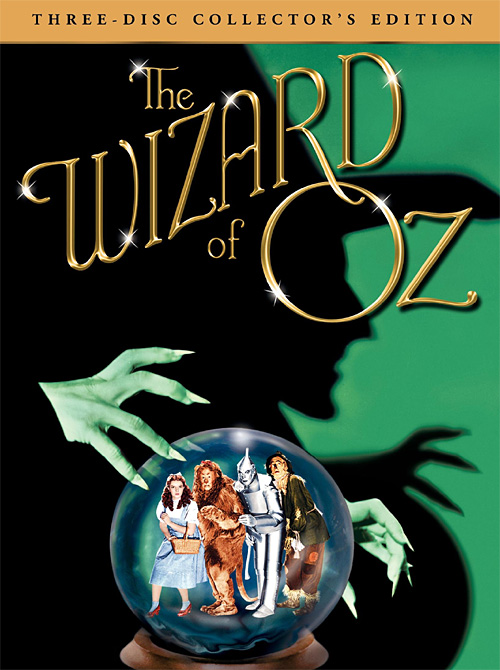 The 3 Disc Limitied Collector's Edition
The 3 Disc Limitied Collector's Edition
This Edition includes all the features of the 2 disc version...plus
Disc 3: Four hours devoted to Oz creator L. Frank Baum, who published his first Oz book in 1900.
* New documentary L. Frank Baum: The Man Behind the Curtain
* Pre-1939 versions of Oz on screen: The Wizard of Oz (1910)
The Magic Cloak of Oz (1914)
His Majesty, The Scarecrow of Oz (1914)
The Wizard of Oz (1925): restored silent version featuring Oliver Hardy and Larry Semon, with a new, fully orchestrated score by Robert Israel
The Wizard of Oz (1933 Cartoon)
Print Reproductions Include:
* The Wizard of Oz Comes to Life
Eight-page Grauman's Chinese Theatre Souvenir Premiere Program from August 15, 1939
* Studio's Invitation to The Grauman's Premiere and the envelope that included tickets to the original Opening Night -with a newly designed commemorative ticket
* Metro-Goldwyn-Mayer Studio News
Sixteen-page edition of the studio’s internal "house organ" newspaper, celebrating the release of The Wizard of Oz on August 14, 1939
* Photoplay Studies Rare secondary-education study guide to the film -Volume V, Number 12 (circa August 1939) -completely devoted to The Wizard of Oz, with articles revealing surprising insights from its producer, director, cameraman and scenarists.
* Deluxe Collectors' Portfolio-Reproductions of original 1939 Kodachrome publicity stills, including nine portraits and on set photographs.
|
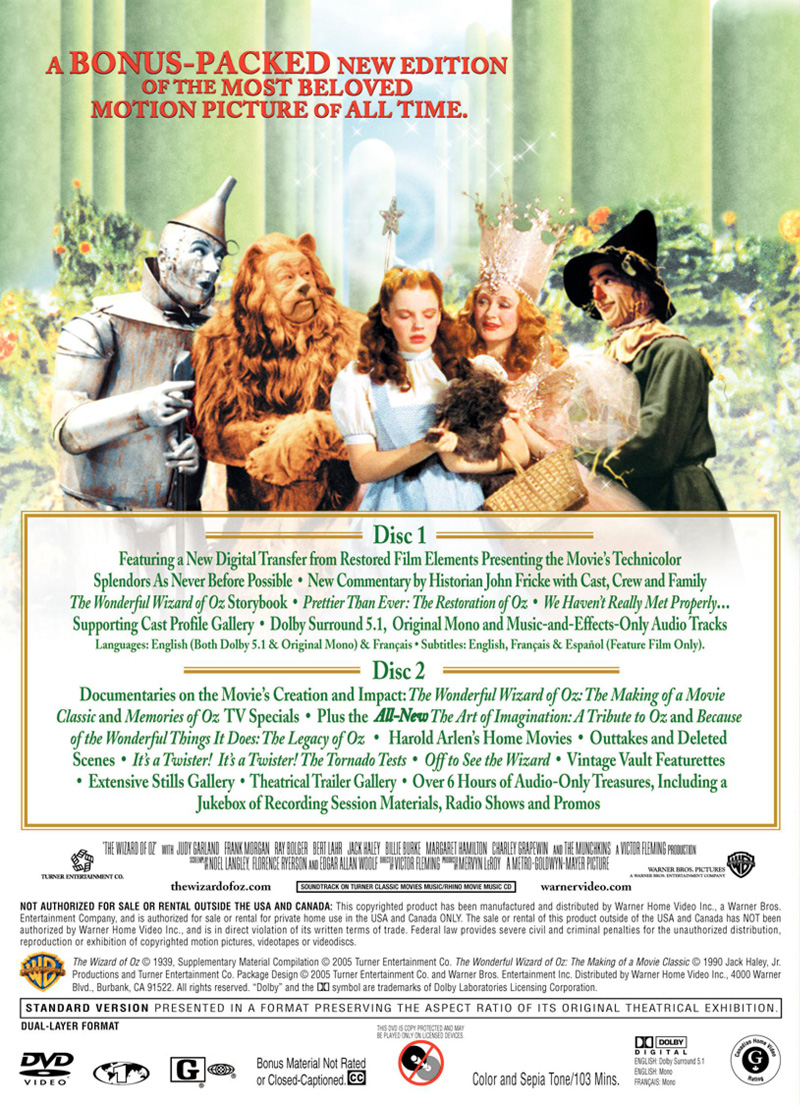 Back Cover Art for the 2 Disc Special Edition
Back Cover Art for the 2 Disc Special Edition
|
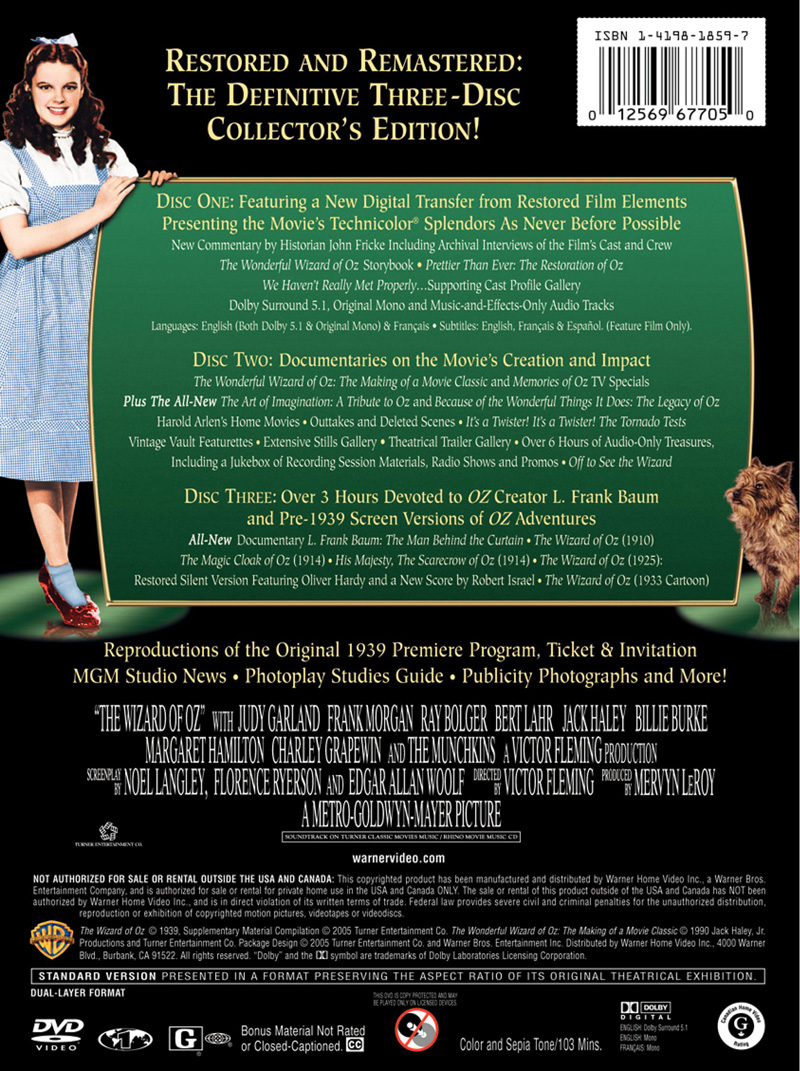 Back Cover art for the 3 Disc Collector's Edition
Back Cover art for the 3 Disc Collector's Edition
|
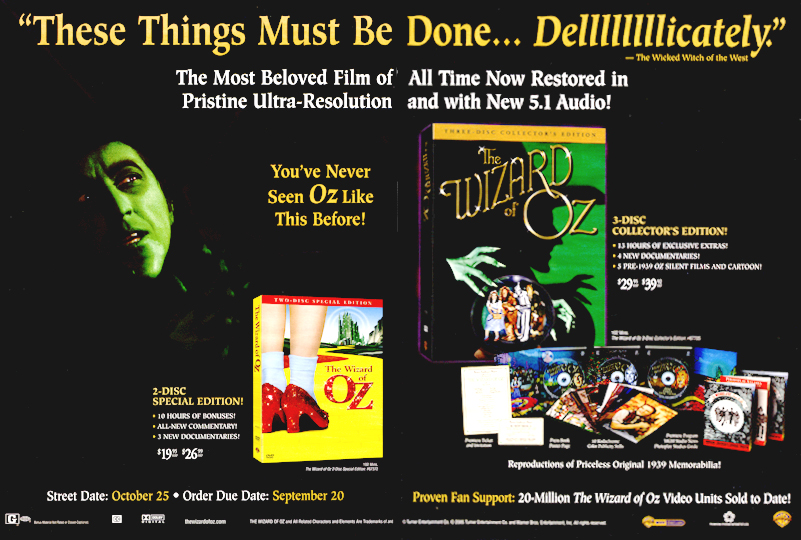 Official Oz DVD Trade Ad.
Official Oz DVD Trade Ad.
|
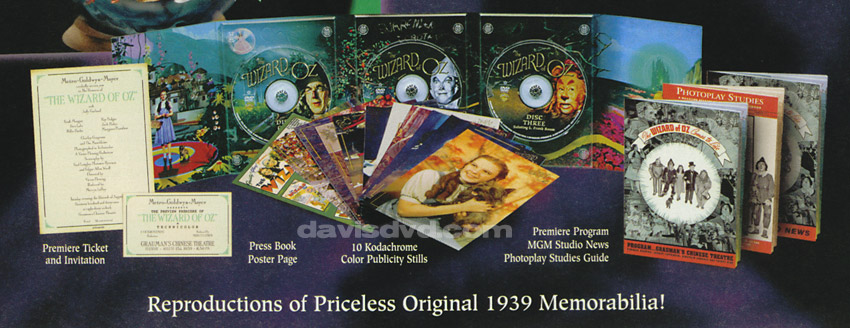 Detailed photo of the contents of the 3 Disc Collector's edition
Detailed photo of the contents of the 3 Disc Collector's edition
|
 Visit www.thewizardofoz.com Today!
Visit www.thewizardofoz.com Today!
Own The Wizard of Oz in TWO sparkling NEW editions: THE WIZARD OF OZ: 2 Disc Special Edition &
THE WIZARD OF OZ: 3 Disc Collector's Edition
____
Now Available!
|
|
|


